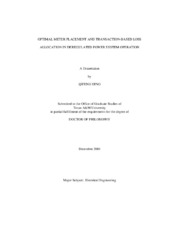| dc.description.abstract | In this dissertation topics of optimal meter placement and transaction-based loss allocation in deregulated power system operation are investigated.
Firstly, Chapter II introduces the basic idea of candidate measurement identification, which is the selection of candidate measurement sets, each of which will make the system observable under a given contingency (loss of measurements and network topology changes). A new method is then developed for optimal meter placement, which is the choice of the optimal combination out of the selected candidate measurement sets in order to ensure the entire system observability under any one of the contingencies.
A new method, which allows a natural separation of losses among individual transactions in a multiple-transaction setting is proposed in Chapter III. The proposed method does not use any approximations such as a D.C. power flow, avoiding method induced inaccuracies. The power network losses are expressed in terms of individual power transactions. A transaction-loss matrix, which illustrates the breakdown of losses introduced by each individual transaction and interactions between any two transactions, is created. The network losses can then be allocated to each transaction based on the transaction-loss matrix entries.
The conventional power flow analysis is extended in Chapter IV to combine with the transaction loss allocation. A systematic solution procedure is formed in order to adjust generation while simultaneously allocating losses to the generators designated by individual transactions.
Furthermore, Chapter V presents an Optimal Power Flow (OPF) algorithm to optimize the loss compensation if some transactions elect to purchase the loss service from the Independent System Operator (ISO) and accordingly the incurred losses are fairly allocated back to individual transactions. IEEE test systems have been used to verify the effectiveness of the proposed method. | en |


